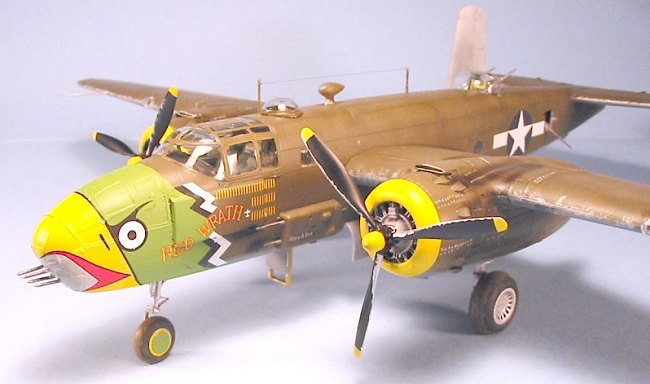
|
KIT: |
Accurate Miniatures 1/48 B-25C/D Mitchell |
|
KIT # |
3431 |
|
PRICE: |
$47.98 MSRP |
|
DECALS: |
Two options |
|
REVIEWER: |
Tom Cleaver |
|
NOTES: |

|
HISTORY |
The Air Apaches Strike Rabaul:
1030 hours,
October 18, 1943: 36 B-25 Mitchells of the 345th Bomb Group,
“the Air Apaches,” form up over Oro Bay on the northern coast of New
Guinea, north of Dobodura Airfield. Deputy Group Commander, Lt. Col.
Clinton L. True, in “Red Wrath” of the 498th “Falcons” Bomb
Squadron, leads the formation, followed by the 501st “Black
Panthers” squadron in second position, the 499th “Bats Outta
Hell” squadron in third place, and the 500th “Rough Raiders”
in trail. True leads the Mitchells east-northeast, out over the Bismarck
Sea. The squadrons settle into formation at 2,000 feet - three
“vee-of-vees” each, nine aircraft per unit. The target is Rabaul, 200
miles across the ocean on the island of New Britain; this is the first
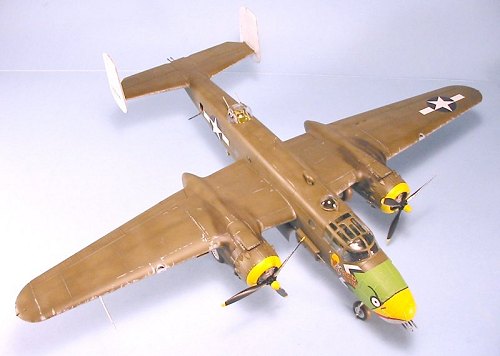 daylight strike by the Fifth Air Force against the heavily-defended
Japanese base. Though no one aboard the bombers knows it, this is the
opening bell of a 120-day air campaign that will see Japanese air power
removed as an offensive force in the Southwest Pacific theater and Rabaul
reduced to a by-passed target.
daylight strike by the Fifth Air Force against the heavily-defended
Japanese base. Though no one aboard the bombers knows it, this is the
opening bell of a 120-day air campaign that will see Japanese air power
removed as an offensive force in the Southwest Pacific theater and Rabaul
reduced to a by-passed target.
In the third flight of the 499th formation is “Dirty Dora,” a hand-me-down B-25C from the 38th Bomb Group and a veteran of the Battle of the Bismarck Sea the previous April. Her pilot, 1st Lt. Vic Tatelman, concentrates on flying wing to flight leader and squadron C.O. Captain Julian B. Baird. The morning briefing was to the point: “Photo recon has spotted 89 fighters, 65 medium bombers and 21 light bombers on the five fields around Rabaul. Your target is Rapopo air field. There is light, medium and heavy flak surrounding all airfields.” As Tatelman recalled, “Our Australian Liaison Officer said ‘When you go down...ahhh, if you go down - make your way to this location,’ as he pointed to a map location on New Britain. Nobody laughed at his mistake.”
October 18th was planned to be a maximum-strength effort for the Fifth Air Force. Two groups of B-24s with fighter escort were to simulate an attack on Rabaul town 30 minutes before the B-25s arrived, to draw the defending fighters up. The B-24s would then bomb three of the five airfields, tearing up the strips and leaving only Rapopo and Tobera open. The 345th and the 38th Bomb Groups would then attack the two strips, catching the refueling enemy fighters on the ground. The attack would be a low-level strafing mission, shooting up the airfields while dropping parafrags and daisy-cutters to finish the job.
Major Paul "Pappy" Gunn had experimented on increasing the B‑25's offensive power, removing the bombardier‑navigator from the greenhouse nose, covering that with metal plates and mounting four .50 caliber guns, with another four in two twin-gun mounts to either side of the cockpit - thus was born the B‑25 "Strafer," a brilliant weapon for use against enemy airbases and sea power. This destructive power was sufficient to make the superstructure of an enemy ship dissolve as the armor‑piercing incendiaries hit it.
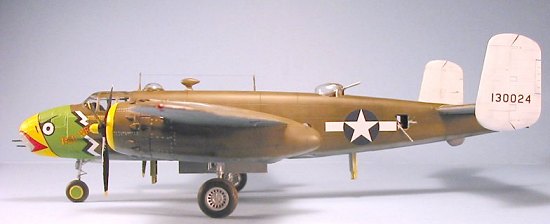 In “Jayhawk,”
lead ship of the second flight on the right side of the vee-of-vees
formation, flight leader 1st Lt. George L. Cooper keeps
formation on mission leader Capt. Orin N. Loverin, and checks his two
wingmen, 1st Lieutenants William M. Parke to the right and
William W. Cabell to the left. Ahead, a line of clouds rears high over
the ocean directly across the track to Rabaul. Cooper hears the P-38s of
the 475th Fighter Group call in that they are aborting the
mission due to weather. “We had been briefed that it was likely we could
find a squall line between New Guinea and New Britain. If we did, the
B-24s would not penetrate the squall and the fighters would turn back,”
Cooper remembered.
In “Jayhawk,”
lead ship of the second flight on the right side of the vee-of-vees
formation, flight leader 1st Lt. George L. Cooper keeps
formation on mission leader Capt. Orin N. Loverin, and checks his two
wingmen, 1st Lieutenants William M. Parke to the right and
William W. Cabell to the left. Ahead, a line of clouds rears high over
the ocean directly across the track to Rabaul. Cooper hears the P-38s of
the 475th Fighter Group call in that they are aborting the
mission due to weather. “We had been briefed that it was likely we could
find a squall line between New Guinea and New Britain. If we did, the
B-24s would not penetrate the squall and the fighters would turn back,”
Cooper remembered.
Out ahead, Lt. Col. True holds “Red Wrath” on an unwavering course toward the clouds which can now be seen as a huge squall line stretching across the Bismarck Sea. The other 35 Mitchells of the 345th head on, followed by the three squadron formations from the 38th B.G.
In “Dirty Dora,” Tatelman hears the command from base H.Q. to abort the mission and turn back. “I looked out, and Colonel True was penetrating the front as if nothing had been said. We all followed.” True, a career Air Corps pilot with ten years’ service, had the group nickname “Fearless.” He would later claim not to have heard the recall order. “I never believed that,” recalls Cooper, “and neither did anyone else in the group. We all heard the order, but we were all young and tough then. I liked Colonel True because he was aggressive and wanted to fight the war. I wouldn’t have liked following someone who wasn’t like that.”
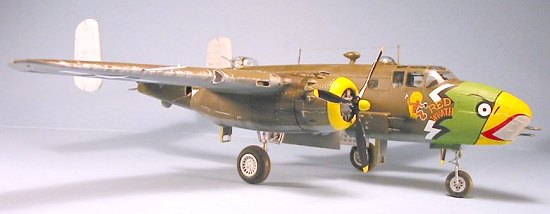 In moments,
the bombers were flying through heavy rain and severe turbulence. “Pilot
tension in one airplane flying IFR is tough enough, but to have fifty
airplanes on instruments in the same area, and all the turbulence...that
made it as tough as can be,” Tatelman recalled. In “Jayhawk,” Cooper
couldn’t see anything through the windshield, due to the heavy rain
within the storm. “All I could see to either side were my wingmen,
tucked in as close as they could get without colliding. The turbulence
was really heavy, and I was afraid of us flying into one of the other
flights, so I took us down. I had to open the side window so I could see
the ocean well enough to avoid flying into it. We went through the storm
at about 60 feet above the wave tops.”
In moments,
the bombers were flying through heavy rain and severe turbulence. “Pilot
tension in one airplane flying IFR is tough enough, but to have fifty
airplanes on instruments in the same area, and all the turbulence...that
made it as tough as can be,” Tatelman recalled. In “Jayhawk,” Cooper
couldn’t see anything through the windshield, due to the heavy rain
within the storm. “All I could see to either side were my wingmen,
tucked in as close as they could get without colliding. The turbulence
was really heavy, and I was afraid of us flying into one of the other
flights, so I took us down. I had to open the side window so I could see
the ocean well enough to avoid flying into it. We went through the storm
at about 60 feet above the wave tops.”
Once through the front, the crews found their flights widely separated, and pilots concentrated on closing formation as Colonel True headed for Kabanga Bay on new Britain, now visible in the distance. Tension rose in the individual aircraft, with voices on the intercoms clipped, talk reduced to monosyllables. The pilots held formation as the gunners test-fired their weapons. As the Mitchells crossed the coast of New Britain, the 38th Bomb Group turned away to attack their target, while the “Air Apaches” dropped lower over the deep green jungle.
“Our strafing tactic was to approach the target at 500 feet, then begin our dive from the Initial Point, bringing the throttles up to METO power so that we came across at treetop height and doing about 310 m.p.h.,” George Cooper explained. “Going in as the third squadron, we knew the defenses would be waiting for us, so you wanted to fly the airplane as fast as you could, as low as you could, so they didn’t have time to track you with any accuracy.”
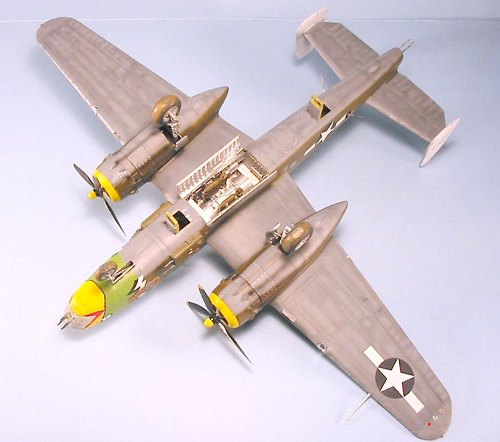 “When we got
to the initial point, Loverin overflew it, so he had to make a tight left
turn to get back,” Cooper remembered. “As the outside flight of the
formation, we had to advance our throttles to full power to keep from
lagging, while Baird’s flight had to reduce power to keep with Loverin.
When we rolled out on the IP and commenced the run-in for the attack, I
had full power and we leaped ahead of Loverin’s flight. Baird’s flight
put their throttles to full as they came out of the turn, and they also
passed Loverin.”
“When we got
to the initial point, Loverin overflew it, so he had to make a tight left
turn to get back,” Cooper remembered. “As the outside flight of the
formation, we had to advance our throttles to full power to keep from
lagging, while Baird’s flight had to reduce power to keep with Loverin.
When we rolled out on the IP and commenced the run-in for the attack, I
had full power and we leaped ahead of Loverin’s flight. Baird’s flight
put their throttles to full as they came out of the turn, and they also
passed Loverin.”
In “Dirty Dora,” Tatelman and co-pilot 2nd Lt. Willie Graham concentrate together, with Graham’s hands lightly on the controls so that he can take control immediately should Tatelman be hit.
The Mitchells drop even lower as they aim for the target. As Tatelman remembered, “There was no sound except the engines and an occasional word over the radio. I advanced the throttles to METO, with Willie’s hand on mine to hold them. Black smoke poured out of the exhaust and it felt like we were going a thousand miles an hour, down at fifty feet or less. All of a sudden we were over the target and I was concentrating on keeping clear of Julian Baird so I wouldn’t hit him as I pushed the trigger for the nose guns.” Each Mitchell was firing eight .50 caliber machine guns at the Japanese aircraft in their revetments as they roared overhead and opened their bomb bays. The parafrags fell out, drifting down on their target, slowed by small parachutes to give the bomber a chance to avoid the explosions beneath it. “Smoke from the explosions obscured the targets, but they also made it harder for the Jap gunners to hit us. I was surprised by the inaccuracy of the Japanese ack-ack.”
In “Jayhawk,” Cooper had his hands full. “When we came off the target, I looked over at my left wingman and he had a huge hole in his right wing. I slowed so he could maintain control and keep up. My flight separated from the other two, and we never did join up till we were out over the ocean. We were jumped by Zekes and my gunner shot down two of them.”
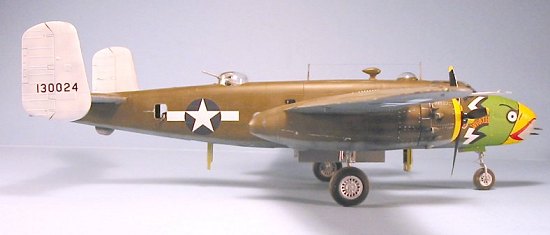 As Tatelman’s
flight of three came off the target and crossed the beach, they spotted
what appeared to be a ferry boat directly in the line of flight. All
three bombers opened fire together, scoring direct hits on the craft as
Japanese troops jump overboard to avoid the massed machine gun fire.
“Off Cape Gazelle, we in the 499th were jumped by fifteen
Zekes. They made twenty-one passes, but mostly broke off before they got
into range. Of the ten that came in close enough, our gunners shot down
three. Once we were out to sea they left us alone.”
As Tatelman’s
flight of three came off the target and crossed the beach, they spotted
what appeared to be a ferry boat directly in the line of flight. All
three bombers opened fire together, scoring direct hits on the craft as
Japanese troops jump overboard to avoid the massed machine gun fire.
“Off Cape Gazelle, we in the 499th were jumped by fifteen
Zekes. They made twenty-one passes, but mostly broke off before they got
into range. Of the ten that came in close enough, our gunners shot down
three. Once we were out to sea they left us alone.”
While the first three squadrons of the 345th hit Rapopo Airfield, the “Rough Raiders” of the 500th squadron turned away and flew down the coast, hunting enemy shipping. They found more trouble than anyone else. Attacking a coastal cargo ship, Lieutenant Wallace’s Mitchell was hit and the left engine was set afire just before he dropped his two 1,000-pounders. The B-25's speed dropped to just barely 150 m.p.h. as he overflew the target, allowing the Japanese gunners below to rake the bomber nose to tail. Wallace’s wingmen, Lieutenants Peterson and Anaker, slowed down to cover him. Attacked by Zekes, Peterson was shot down and the Mitchell exploded with no survivors. Hit badly, Anaker turned back to New Britain where he ditched on the coast; two of his crew survived and were eventually rescued by Australian coast watchers.
Wallace, alone
with a burning engine, took his Mitchell low over the ocean, where they
survived a 30-minute running battle with Zekes in which five fighters
flew into the water trying to shoot them down, while they also shot down
two of the attackers. With his co-pilot wounded in the stomach and still
conscious, Wallace brought the wounded B-25 to a safe landing on the
emergency strip on Kiriwina in the Trobriand Islands.
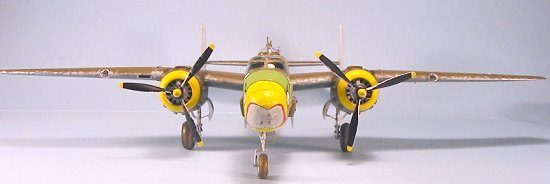
Back home at Dobodura, there was trouble. While the 345th had shot down twenty-two defending Japanese fighters with five probables, and many more from strafing, with a loss of only two Mitchells, Colonel Frederick Smith of the First Air Task Force didn’t believe Lt. Col. True’s story that his radio operator had failed to receive the recall order, and was prepared to nail the mission commander for disobeying orders. Three days later, True reported to Fifth Air Force commander General George Kenney in Brisbane, Australia, where he saw headlines in the local papers: “MacArthur Using Daring New Tactics, Sends B-25s Over Rabaul Unescorted.” He repeated his story about not receiving the order. Kenney didn’t believe him any more than the pilots had, but in view of the overall success of the mission a court-martial was deemed inappropriate. Instead, True was awarded the Distinguished Service Cross for leading the daring mission, and the 345th Bomb Group received the first of an eventual four Distinguished Unit Citations. They would visit Rabaul three more times in the next two weeks. As Tatelman remembered, “none of them were easy, but we started getting used to them.”
During the
war, the 345th Bomb Group flew 58,562
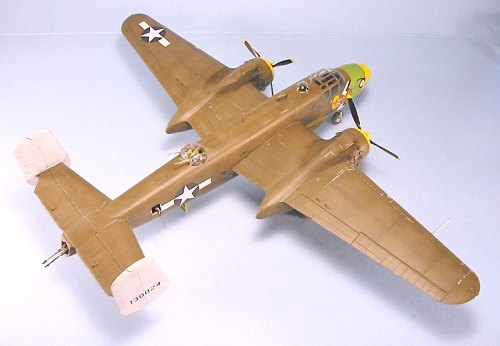 combat hours in 9,120
sorties, dropping 58,000 bombs, with a total weight of 6,340 tons and
fired 12.5 million rounds of ammunition. Crews of the 345th
were credited with sinking 260 vessels for a total 190,000 tons of enemy
shipping, while damaging 275 others. 260 enemy aircraft were destroyed on
the ground, with a further 107 shot down in aerial combat, while losing
177 B-25s. This record came at a cost of 712 dead from all causes, with
580 killed in action. Another 111 - mostly ground personnel waiting to
move ashore to their new base in the Philippines - were killed November
12th, 1944, when the SS “Nelson” and SS “Waite” were attacked by
kamikazes in Leyte Gulf.
combat hours in 9,120
sorties, dropping 58,000 bombs, with a total weight of 6,340 tons and
fired 12.5 million rounds of ammunition. Crews of the 345th
were credited with sinking 260 vessels for a total 190,000 tons of enemy
shipping, while damaging 275 others. 260 enemy aircraft were destroyed on
the ground, with a further 107 shot down in aerial combat, while losing
177 B-25s. This record came at a cost of 712 dead from all causes, with
580 killed in action. Another 111 - mostly ground personnel waiting to
move ashore to their new base in the Philippines - were killed November
12th, 1944, when the SS “Nelson” and SS “Waite” were attacked by
kamikazes in Leyte Gulf.
In the course of 26 months’ service, the 345th participated in nine major campaigns in the Asia‑Pacific Theater, including New Guinea, Bismark Archipelago, Northern Solomons, Southern Philippines, Luzon, Western Pacific, China Defensive, China Offensive, and Air Offensive against Japan, receiving a total of four Distinguished Unit Citations in the course of these actions.
In August of 1945, the Air Apaches were given the great honor of intercepting and escorting the two Japanese "Betty" bombers that were transporting the emissaries who were to initiate the Japanese surrender.
|
THE KIT |
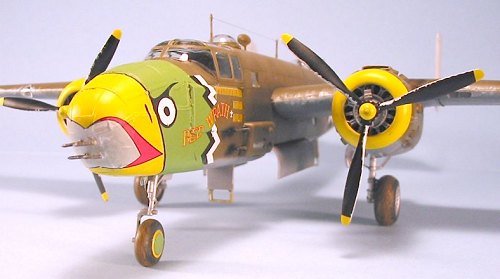 For a look at
what Accurate Miniatures provides in the box,
check out the preview of the B-25B as
they are nearly the same kit.
For a look at
what Accurate Miniatures provides in the box,
check out the preview of the B-25B as
they are nearly the same kit.
When Accurate Miniatures first released their series of early B-25s, some of the more anal modelers criticized the kit for having an inaccurate nose profile, and inaccurate engine cowlings. I’ve studied pictures of the B-25, and these criticisms are valid, but you really have to look to see these items. For me, the kit is “accurate enough.” For those who can’t live with such things, Cutting Edge has created “corrected” engine cowlings (for about half the price of the entire kit to begin with). (Those wanting to improve the look of the kit cowlings can simply roll up a piece of sandpaper to widen the opening. See this review for an example. Ed) I haven’t heard of any corrections for the glass nose parts.
|
CONSTRUCTION |
Quite frankly, if you’ve built one Accurate Miniatures B-25 you’ve built ‘em all, so my construction section will be limited to things I did specifically for this kit that differ from the instructions.
For starters,
this kit did not have the weights included, as did the original A-M
release. I don’t know if this will change with future releases, but the
result was that I took a whole lot of small “cannonball” fish weights,
squashed them flat to allow more of them into a given space, and filled
up the bombardier’s compartment. Since the nose is painted over, this is
an easy solution to the problem. If a modeler wants to do the glass nose
version, they will need to fill up all the area of the fuselage
immediately aft of the nose, to the side of the nose wheel, beneath the
cockpit floor, as well as the engine nacelles immediately behind the
engines ahead of the main gear in order to get a nose-sitter.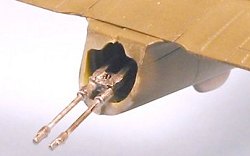
I also saved as much weight as possible in the rear of the fuselage by not putting in any of the interior parts, since you cannot see them anyway when the fuselage is closed up.
I used two .50 cal machine guns that originally came from a Monogram B-26 for the waist guns. These B-25Cs and Ds of the 345th B.G. did not have the Townsend modification for the larger waist windows, that was done later. The tail stinger was included in the kit, and merely meant not placing the clear fuselage cap on.
I did not attach the wings to the fuselage until after I had painted the camouflage, since this made painting the areas between the fuselage and the engine nacelles much easier.
|
COLORS AND MARKINGS |
Painting:
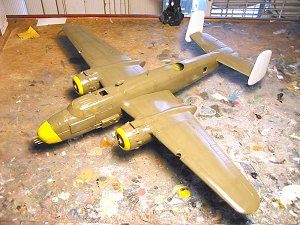 After
pre-shading the model, I painted the nose and the leading edges of the
engine cowls with Tamiya Flat Yellow and masked them off, then painted
the rest of the model with Gunze-Sangyo Olive Drab for the upper surfaces
and Tamiya Neutral Grey for the lower surfaces. I used both shades of
Olive Drab by Gunze, starting with the darker “Olive Drab 1", (which says
“for US tank” on it) then turned to the lighter Olive Drab to fade the
upper surfaces. I added a bit of yellow for further sun fading of the
fabric covered control surfaces, followed by adding some white to that
for overall sun fading of the upper fuselage, and tops of wings and
horizontal stabilizer. Once all this was dry, I gave the model a coat of
Future.
After
pre-shading the model, I painted the nose and the leading edges of the
engine cowls with Tamiya Flat Yellow and masked them off, then painted
the rest of the model with Gunze-Sangyo Olive Drab for the upper surfaces
and Tamiya Neutral Grey for the lower surfaces. I used both shades of
Olive Drab by Gunze, starting with the darker “Olive Drab 1", (which says
“for US tank” on it) then turned to the lighter Olive Drab to fade the
upper surfaces. I added a bit of yellow for further sun fading of the
fabric covered control surfaces, followed by adding some white to that
for overall sun fading of the upper fuselage, and tops of wings and
horizontal stabilizer. Once all this was dry, I gave the model a coat of
Future.
Decals:
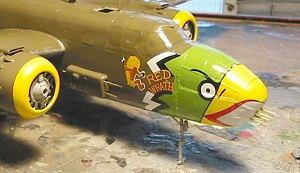 I used the
Eagle Strike decals for Red Wrath. The decals for the “falcon” (it’s
not a parrot, no matter what anyone in the “Bats Outta Hell” say)
don’t really fit, and required a lot of cutting and fiddling to end up
with something that looked right. Accurate Miniatures is going to
re-issue the kit later this year, with these markings; they will be done
with paint and masks - as the “Dirty Dora” markings are - which will be
far easier than this was. The rest of the decals went down with no
problems.
I used the
Eagle Strike decals for Red Wrath. The decals for the “falcon” (it’s
not a parrot, no matter what anyone in the “Bats Outta Hell” say)
don’t really fit, and required a lot of cutting and fiddling to end up
with something that looked right. Accurate Miniatures is going to
re-issue the kit later this year, with these markings; they will be done
with paint and masks - as the “Dirty Dora” markings are - which will be
far easier than this was. The rest of the decals went down with no
problems.
As an historical point, the 345th Bomb Group did not apply their spectacular nose markings to their B-25s until February, 1944, when they were at Friedrichshafen in New Guinea. At the time of the Rabaul raids, the airplanes were all strictly “G.I.”
When all was set, I washed the model to get rid of all the solvent residue, then shot another coat of Future.
|
FINAL ASSEMBLY |
I applied exhaust staining liberally, using Tamiya “Smoke,” then gave the model several coats of thinned Dullcote to give it a flat finish. I stripped off the cockpit masks, inserted the upper gun turret, and attached the propellers.
|
CONCLUSIONS |
The Fifth Air Force B-25s are among the most colorful Mitchells to see combat. They were also among the most deadly, and of all them, the record of the 345th “Air Apaches” is one many bomber groups would be proud to have achieved. I am sure more Air Apaches will appear in my collection, both in the Accurate Miniatures kit and the older Monogram B-25J.
Thanks to Accurate Miniatures for the review kit.
January 2004
|
REFERENCES |
Interview with Vic Tatelman, August 25, 2003.
Interview with George Cooper, August 28, 2003.
(Those seeking THE reference on the 345 BG need to seek out 'Warpath Across the Pacific'. Ed)
If you would like your product reviewed fairly and quickly by a site that has nearly 250,000 visitors a month, please contact me or see other details in the Note to Contributors.